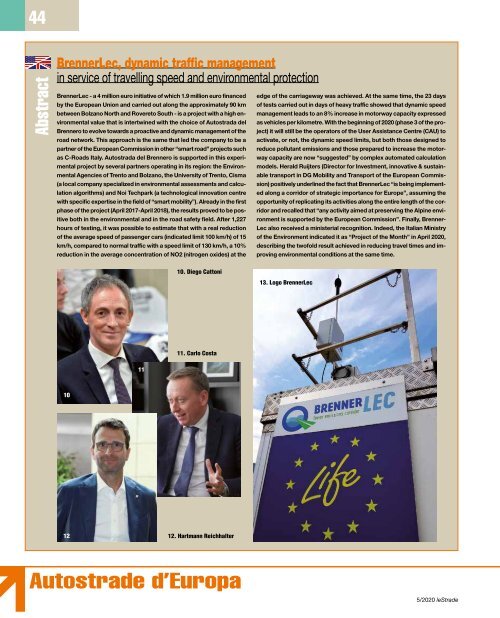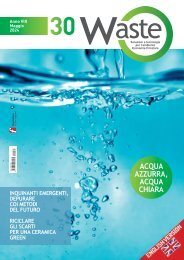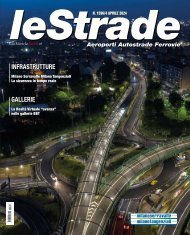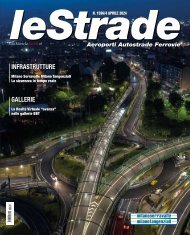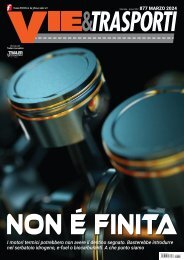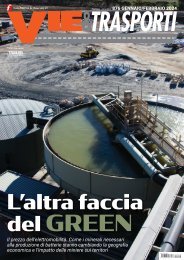leStrade n. 1557 - maggio 2020
- Autostrade: network europei green e innovativi - Ponti: Genova, sollevata l'ultima campata - Materiali: formazione online sul calcestruzzo
- Autostrade: network europei green e innovativi
- Ponti: Genova, sollevata l'ultima campata
- Materiali: formazione online sul calcestruzzo
Create successful ePaper yourself
Turn your PDF publications into a flip-book with our unique Google optimized e-Paper software.
44<br />
Abstract<br />
BrennerLec, dynamic traffic management<br />
in service of travelling speed and environmental protection<br />
BrennerLec - a 4 million euro initiative of which 1.9 million euro financed<br />
by the European Union and carried out along the approximately 90 km<br />
between Bolzano North and Rovereto South - is a project with a high environmental<br />
value that is intertwined with the choice of Autostrada del<br />
Brennero to evolve towards a proactive and dynamic management of the<br />
road network. This approach is the same that led the company to be a<br />
partner of the European Commission in other “smart road” projects such<br />
as C-Roads Italy. Autostrada del Brennero is supported in this experimental<br />
project by several partners operating in its region: the Environmental<br />
Agencies of Trento and Bolzano, the University of Trento, Cisma<br />
(a local company specialized in environmental assessments and calculation<br />
algorithms) and Noi Techpark (a technological innovation centre<br />
with specific expertise in the field of “smart mobility”). Already in the first<br />
phase of the project (April 2017-April 2018), the results proved to be positive<br />
both in the environmental and in the road safety field. After 1,227<br />
hours of testing, it was possible to estimate that with a real reduction<br />
of the average speed of passenger cars (indicated limit 100 km/h) of 15<br />
km/h, compared to normal traffic with a speed limit of 130 km/h, a 10%<br />
reduction in the average concentration of NO2 (nitrogen oxides) at the<br />
edge of the carriageway was achieved. At the same time, the 23 days<br />
of tests carried out in days of heavy traffic showed that dynamic speed<br />
management leads to an 8% increase in motorway capacity expressed<br />
as vehicles per kilometre. With the beginning of <strong>2020</strong> (phase 3 of the project)<br />
it will still be the operators of the User Assistance Centre (CAU) to<br />
activate, or not, the dynamic speed limits, but both those designed to<br />
reduce pollutant emissions and those prepared to increase the motorway<br />
capacity are now “suggested” by complex automated calculation<br />
models. Herald Ruijters (Director for Investment, innovative & sustainable<br />
transport in DG Mobility and Transport of the European Commission)<br />
positively underlined the fact that BrennerLec “is being implemented<br />
along a corridor of strategic importance for Europe”, assuming the<br />
opportunity of replicating its activities along the entire length of the corridor<br />
and recalled that “any activity aimed at preserving the Alpine environment<br />
is supported by the European Commission”. Finally, Brenner-<br />
Lec also received a ministerial recognition. Indeed, the Italian Ministry<br />
of the Environment indicated it as “Project of the Month” in April <strong>2020</strong>,<br />
describing the twofold result achieved in reducing travel times and improving<br />
environmental conditions at the same time.<br />
10. Diego Cattoni<br />
C<br />
13. Logo BrennerLec<br />
M<br />
Y<br />
CM<br />
MY<br />
CY<br />
CMY<br />
11. Carlo Costa<br />
K<br />
11<br />
10<br />
12<br />
12. Hartmann Reichhalter<br />
Autostrade d’Europa<br />
5/<strong>2020</strong> <strong>leStrade</strong>


